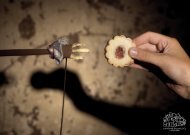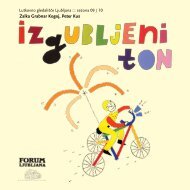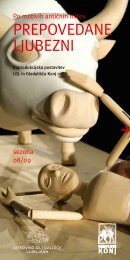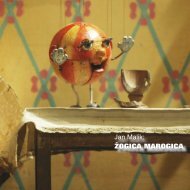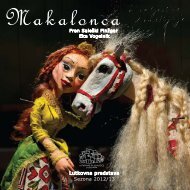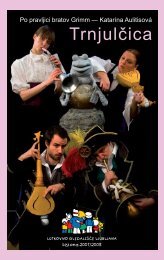Gledališki list - Ljubljana Puppet Theatre
Gledališki list - Ljubljana Puppet Theatre
Gledališki list - Ljubljana Puppet Theatre
You also want an ePaper? Increase the reach of your titles
YUMPU automatically turns print PDFs into web optimized ePapers that Google loves.
DOCTOR FAUSTUS<br />
“Nobody is satisfied with their destiny: A beggar wants to become rich, a rich<br />
man wants to become a king, a king wants to subdue the world … I’d like to<br />
see all, know all …”<br />
Doctor Faustus is undoubtedly one of the most prominent characters in European<br />
literary history. The motif of the story about a scholar who sells his soul<br />
to the devil in his desire for absolute knowledge of the world can be tracked<br />
down to the European Middle Ages. Its origin however can be found in the<br />
legend of Theophilus brought to Europe from Asia Minor in the 11th century,<br />
and written down as a play in 13th century France. Different German variants<br />
followed. Faustus as the title hero first appears in Christopher Marlowe’s drama<br />
from the 16th century. Doctor Faust became one of the most popular plays<br />
performed by travelling puppet theatre companies in 17th and 18th century<br />
Germany, spreading as part of puppeteers’ standard repertory throughout<br />
Central Europe. The great German poet Goethe saw a play and transformed it<br />
into his famous epic. Nevertheless, Faustus has spent the most of his theatre<br />
life on the puppet theatre stage.<br />
The Slovenian Doctor Faustus puppet production of 1938 in <strong>Ljubljana</strong> was the<br />
creative pinnacle of Slovenian puppetry pioneer, painter<br />
MILAN KLEMEN»I» (1875 — 1957),<br />
who used the Leipzig text of the play, adapted and produced it at his Little<br />
Marionette <strong>Theatre</strong>.<br />
Milan KlemenËiË was fascinated by puppets as a child in Gorizia watching<br />
shows performed by Italian puppeteer Reccardini. Studying art in Venice,<br />
Milan and Munich, he visited puppet theatres in those cities, enjoying above<br />
all productions by “Papa” Schmid and the famous Munich artists’ Marionette<br />
<strong>Theatre</strong>. Following their example he set to work on his own.<br />
On 22nd December 1910, he opened the door of Little Marionette <strong>Theatre</strong> at<br />
his home in ©turje by AjdovπËina — with a stage opening measuring 40 cm by<br />
23 cm, and 10 cm “tall” puppets. The opening of The Dead Man In The Red Coat<br />
marked the birth of Slovenian puppet theatre, since only rudimentary forms<br />
of folk puppetry had been known in Slovenia until then. KlemenËiË designed<br />
and made his own stage, puppets and sets, directed and performed (aided by<br />
his wife). By the beginning of World War 1 he and his family produced five more<br />
plays, premiering two in Graz, Austria, where he was stationed as a reserve<br />
officer of the Austrian army.<br />
After the war, he and his family moved to <strong>Ljubljana</strong> where the <strong>Ljubljana</strong><br />
<strong>Theatre</strong> Consortium, on writer Ivan Lah’s initiative, had appointed him head<br />
of Slovenian Marionette <strong>Theatre</strong>, the first (semi)professional puppet theatre<br />
in the former Kingdom of Serbs, Croats and Slovenes. The theatre operated<br />
in the building of Town Centre from 1920 to 1924 when it was forced to close<br />
down, primarily due to financial problems, in spite of all the enthusiasm and<br />
support of prominent artists.<br />
The disillusioned artist returned to his great love, the puppets, only a good<br />
ten years later, and opened the curtain of the Miniature <strong>Puppet</strong>s theatre in<br />
his living room on 26th April 1936. The production of Pocci’s The Owl’s Castle<br />
would seat 30 invited guests per show, mostly <strong>Ljubljana</strong> intellectuals to<br />
whom shows of this small theatre (with just 12 cm puppets) were true cultural<br />
delicacies. The artist’s creativity had reached maturity by that period, and<br />
culminated in Doctor Faustus. <strong>Puppet</strong>ry and fine art merged in it into a perfect<br />
stage image.<br />
A proof of excellence of KlemenËiË’s creative work, which put Slovenian puppetry<br />
among of the highest European achievements of the time overnight, so<br />
to speak, is the fact that the international puppeteers’ organisation, UNIMA<br />
accepted him posthumously as honorary member a year after his death.<br />
The artist’s legacy, taken over from his heirs, is in the custody of Lutkovno<br />
GledaliπËe <strong>Ljubljana</strong> which has revived the two shows of the Miniature <strong>Puppet</strong>s<br />
theatre. In order to preserve the fragile originals as a precious piece of<br />
Slovenian art history, we have made exact copies of Doctor Faustus puppets<br />
using them in our regular programme.<br />
Matjaæ Loboda



